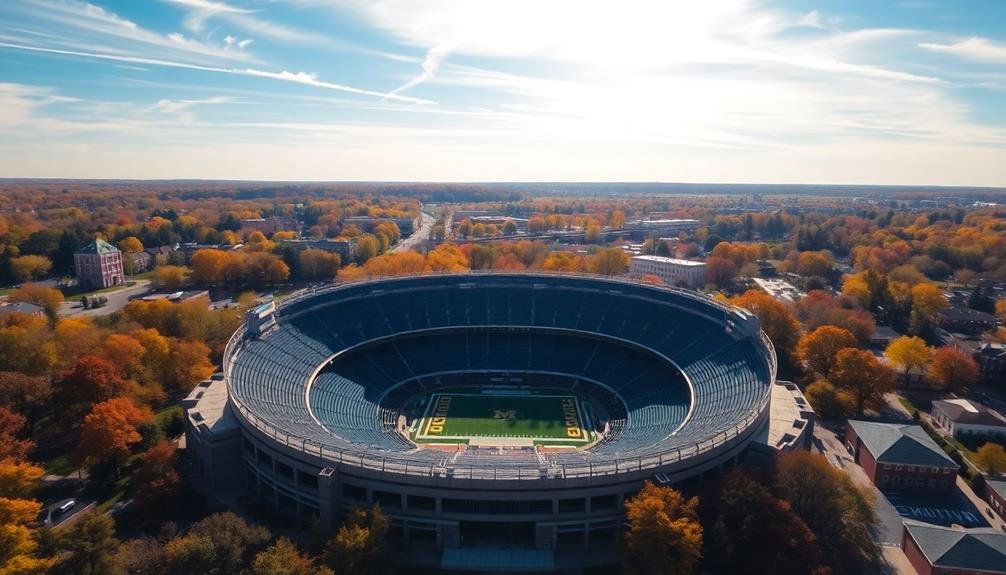You'll be awestruck by these three breathtaking aerial tours of iconic sports stadiums. Soar over Rio's Maracanã Stadium, a colossal concrete oval steeped in football history. Next, marvel at Barcelona's Camp Nou, Europe's largest stadium with its distinctive blue and red seating. Finally, witness the sheer scale of Michigan Stadium, "The Big House," as you glide above its unique bowl shape. These flyovers showcase the architectural grandeur and cultural significance of each venue, from their perfectly manicured pitches to their capacity to host over 100,000 passionate fans. Prepare to be amazed as you explore these sporting cathedrals from a bird's-eye view.
Maracanã Stadium, Rio De Janeiro
As you soar over Rio de Janeiro, the Maracanã Stadium emerges as a colossal concrete oval amidst the vibrant cityscape. This iconic venue, once the world's largest football stadium, stands as a monument to Brazil's passion for the beautiful game. From above, you'll notice its distinctive circular shape, which offers unobstructed views for up to 78,838 spectators.
The stadium's recent renovations for the 2014 FIFA World Cup and 2016 Olympics are visible from your aerial vantage point. You'll spot the new roof structure, covering most of the seating areas while leaving the playing field open to the sky.
The flyover reveals the stadium's strategic location, nestled between Tijuca Forest and Guanabara Bay. As you circle the Maracanã, you'll appreciate its historical significance. This is where Pelé scored his 1000th goal and where the dramatic 1950 World Cup final unfolded.
The surrounding area showcases Rio's unique topography, with Sugarloaf Mountain and Christ the Redeemer visible in the distance. Your aerial tour of the Maracanã offers a unique perspective on this legendary sports venue and its place in Rio's spectacular landscape.
Camp Nou, Barcelona
When you fly over Barcelona, Camp Nou stands out as a colossal fortress of football. As Europe's largest stadium, it's an impressive sight from above, with its distinctive oval shape and striking blue and red seats visible even from great heights.
You'll notice the stadium's massive footprint, covering nearly 55,000 square meters and capable of hosting almost 100,000 passionate fans.
From the air, you can appreciate Camp Nou's unique design, featuring a steep-tiered seating arrangement that creates an intimidating atmosphere for visiting teams. The stadium's open-air design allows you to see the perfectly manicured pitch, which appears as a lush green rectangle amidst the concrete structure.
As you circle the stadium, you'll spot the nearby training facilities and the FCB Escola youth academy, showcasing Barcelona's commitment to developing future talent.
The surrounding area is a mix of residential buildings and open spaces, highlighting Camp Nou's integration into the urban landscape.
Your aerial tour wouldn't be complete without noticing the stadium's ongoing renovation project, which aims to modernize the facility while preserving its iconic status in the world of football.
Michigan Stadium, Ann Arbor

Soaring over Ann Arbor, you'll instantly spot the massive Michigan Stadium, affectionately known as "The Big House." This colossal structure dominates the landscape, boasting the title of largest stadium in the United States and the third-largest in the world.
As you circle above, you'll notice the stadium's unique bowl shape, which keeps the playing field below ground level. This design allows for an impressive seating capacity of over 107,000 fans, creating an electrifying atmosphere during game days.
From your aerial vantage point, you'll see the iconic block "M" at midfield, a symbol of the University of Michigan's pride. The stadium's recent renovations are also visible, including the addition of luxury boxes and wider aisles for improved fan comfort.
You can't miss the sea of maize and blue that fills the stands during football games, creating a vibrant spectacle from above. The stadium's proximity to campus buildings and the surrounding Ann Arbor community is evident, highlighting its integral role in the university's culture.
As you complete your flyover, you'll gain a new appreciation for the sheer scale and impact of this legendary sporting venue.
Frequently Asked Questions
How High Do Aircraft Typically Fly During Stadium Flyovers?
You'll typically see aircraft flying between 500 to 1,000 feet above ground level during stadium flyovers. They're required to maintain a minimum altitude of 500 feet over congested areas, but can fly lower with special permission.
Are There Specific Regulations for Conducting Stadium Flyovers?
Yes, there are specific regulations for stadium flyovers. You'll need FAA approval, maintain minimum altitudes, and follow strict safety protocols. You must also coordinate with stadium officials and local authorities to guarantee a safe, compliant flyover.
Which Types of Aircraft Are Most Commonly Used for Stadium Flyovers?
You'll typically see military jets like F-16s or F/A-18s performing stadium flyovers. They're fast, loud, and impressive. Occasionally, you might spot larger aircraft like C-130 transports or civilian planes for special events. It's always an exciting spectacle.
How Much Do Stadium Flyovers Cost to Organize?
You'll find that stadium flyovers can be quite costly. They're often free for the venue, as military branches use them for training. However, operational expenses can reach $60,000 per hour for fighter jet formations.
Can Private Individuals or Companies Arrange Stadium Flyovers for Special Events?
You can arrange stadium flyovers for special events, but it's challenging. You'll need FAA approval, coordination with the stadium, and a licensed pilot. It's costly and time-consuming, so most people hire professional companies instead.
In Summary
You've just experienced the thrill of soaring over some of the world's most iconic sports stadiums. From the vibrant energy of Rio's Maracanã to the storied history of Barcelona's Camp Nou and the sheer size of Michigan's "Big House," you've seen these venues from a whole new perspective. Next time you're watching a game, you'll appreciate the grandeur of these architectural marvels even more. Why not plan your own stadium flyover adventure?

As educators and advocates for responsible drone use, we’re committed to sharing our knowledge and expertise with aspiring aerial photographers.




Leave a Reply